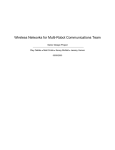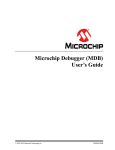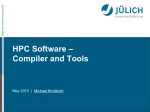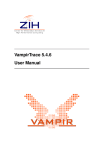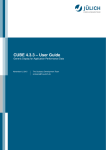Download ScaMPI User`s guide
Transcript
ScaMPI User’s guide
Copyright © 1999-2000 Scali AS. All rights reserved.
Acknowledgement
The development of ScaMPI has benefited greatly from the work of people not
connected to Scali. We wish especially to thank the developers of MPICH for their work
which served as a reference when implementing the first version of ScaMPI.
The list of persons contributing to algorithmic ScaMPI improvements are impossible
to compile here. We apologise to those who remain unnamed and mention only those
who certainly are responsible for a step forward.
Scali is thankful to Rolf Rabenseifner for the improved reduce algorithm used in
ScaMPI.
Table of contents
Chapter 1 Introduction...............................................................................................7
1.1 Purpose of the ScaMPI User’s guide.........................................................................7
1.2 Scope of the ScaMPI User’s guide.............................................................................7
1.3 Required knowledge ..................................................................................................8
1.4 Abbreviations and Acronyms ....................................................................................9
1.5 Basic terms ..............................................................................................................10
1.6 Typographic conventions.........................................................................................10
Chapter 2 Getting started ....................................................................................... 11
2.1 An example program ...............................................................................................11
2.1.1 Setting up your BASH environment ........................................................11
2.1.2 Hello-world.c - source in C ........................................................................12
2.1.3 Hello-world.f - source in Fortran ..............................................................12
2.1.4 Compiling...................................................................................................12
2.1.5 Linking.......................................................................................................12
2.1.6 Running .....................................................................................................13
2.2 MPI test programs...................................................................................................13
2.2.1 Producer - a producer-consumer MPI test program................................13
2.2.2 Bandwidth - a bandwidth MPI test program...........................................14
2.2.3 Bidirect - a bidirectional MPI test program.............................................14
Chapter 3 Using ScaMPI ......................................................................................... 15
3.1 Setting up a ScaMPI environment .........................................................................15
3.1.1 ScaMPI environment variables ................................................................15
3.2 Compiling .................................................................................................................16
3.2.1 Compiler support.......................................................................................16
3.2.2 Compiler flags............................................................................................17
3.3 Linking .....................................................................................................................17
3.4 Running MPI programs...........................................................................................17
3.4.1 mpimon - monitor program.......................................................................18
3.4.1.1 Basic usage ............................................................................................... 18
3.4.1.2 Advanced usage........................................................................................ 18
3.4.2 mpirun - wrapper script............................................................................23
3.4.2.1 mpirun usage ............................................................................................ 23
3.5 Debugging ScaMPI applications .............................................................................25
3.5.1 Debugging with a parallel debugger ........................................................25
3.5.1.1 What is TotalView?.................................................................................. 25
3.5.1.2 TotalView user environment setup .......................................................... 25
3.5.1.3 Debugging using TotalView .................................................................... 26
3.5.2 Debugging with a sequential debugger....................................................27
ScaMPI User’s Guide Version 1.10
3
3.6 Profiling ScaMPI applications ................................................................................27
3.6.1 Profiling and analysing using Vampirtrace and Vampir ........................28
3.6.1.1 What is Vampirtrace?............................................................................... 28
3.6.1.2 What is Vampir?....................................................................................... 28
3.6.1.3 Vampirtrace and Vampir user environment setup.................................... 29
3.6.1.4 Linking an ScaMPI application with Vampirtrace................................... 29
3.6.1.5 Running an ScaMPI application with Vampirtrace.................................. 30
3.6.1.6 Analyzing an ScaMPI application using Vampir ..................................... 30
3.6.2 Profiling with ScaMPE .............................................................................31
Chapter 4 Description of ScaMPI.......................................................................... 35
4.1 General description .................................................................................................35
4.1.1 ScaMPI libraries........................................................................................35
4.1.2 ScaMPI executables ..................................................................................35
4.1.2.1 mpimon - monitor program ...................................................................... 35
4.1.2.2 mpisubmon - submonitor program........................................................... 35
4.1.2.3 mpiboot - bootstrap program.................................................................... 35
4.1.2.4 mpid - daemon program ........................................................................... 35
4.2 Starting ScaMPI application programs..................................................................36
4.2.1 Application startup - phase 1 ...................................................................36
4.2.2 Application startup - phase 2 ...................................................................37
4.2.3 Application startup - phase 3 ...................................................................38
4.3 Stopping ScaMPI application programs.................................................................39
4.4 Communication resources .......................................................................................39
4.4.1 Channel buffer...........................................................................................40
4.4.2 Eagerbuffer buffer .....................................................................................41
4.4.3 Transporter buffer.....................................................................................42
4.5 Communication protocols........................................................................................43
4.5.1 Inlining protocol ........................................................................................44
4.5.2 Eagerbuffering protocol ............................................................................45
4.5.3 Transporter protocol .................................................................................46
Chapter 5 Tips &Tricks .......................................................................................... 47
5.1 Application program notes ......................................................................................47
5.1.1 MPI_Probe() and MPI_Recv() ...................................................................47
5.1.2 Unsafe MPI programs ...............................................................................48
5.2 Namespace pollution ...............................................................................................49
5.3 Error and warning messages ..................................................................................49
5.3.1 User interface errors and warnings .........................................................49
5.3.2 Fatal errors................................................................................................49
5.4 When things don’t work - troubleshooting .............................................................50
5.5 How to optimize MPI performance .........................................................................57
5.6 Benchmarking..........................................................................................................59
Chapter 6 Support .................................................................................................... 61
ScaMPI User’s Guide Version 1.10
4
6.1 Feedback ..................................................................................................................61
6.2 Scali mailing lists ....................................................................................................61
6.3 ScaMPI FAQ ............................................................................................................61
6.4 ScaMPI release documents .....................................................................................61
6.5 Problem reports .......................................................................................................62
6.6 Platforms supported ................................................................................................62
6.7 Licensing ..................................................................................................................62
Chapter 7 Related documentation ........................................................................ 63
7.1 References ................................................................................................................63
Appendix A ScaMPI installation................................................................................................ 65
A-1 Installing ................................................................................................................................. 65
A-1.1 Requirements .......................................................................................................... 65
A-1.2 Distribution file....................................................................................................... 65
A-1.3 Licensing ................................................................................................................ 66
A-2 The Scali System directory tree ............................................................................................. 67
A-3 Useful 3rd party parallel software .......................................................................................... 67
Chapter 8 List of figures.......................................................................................... 69
ScaMPI User’s Guide Version 1.10
5
ScaMPI User’s Guide Version 1.10
6
Chapter 1
Introduction
A Scali System is a set of SCI interconnected nodes, where each node is a
multiprocessor workstation or PC, running either Solaris or Linux. To get the full
computational power of a Scali System it is necessary to use ScaMPI. ScaMPI is Scali’s
high performance MPI implementation. The programming environment for ScaMPI
provides a variety of options and tools for tuning and debugging. In addition, ScaMPI
is integrated with powerful third party software.
ScaMPI utilises shared memory on intra node communication, and the fast SCI
interconnect on inter node communication. Any parallel MPI-conforming application
can be run with ScaMPI, and benefit from the SCI performance.
1.1 Purpose of the ScaMPI User’s guide
This document describes ScaMPI, the Scali implementation of the Message Passing
Interface version 1.1 [1].
Its purpose is:
• to supply the user with enough information to use ScaMPI.
• to give the interested reader an overview of the ScaMPI implementation.
The guide is neither a tutorial in using MPI, nor a guide on how to design efficient MPI
programs.
1.2 Scope of the ScaMPI User’s guide
This document has the following layout:
• Chapter 2 - explains how to get started running your first MPI program with
ScaMPI.
• Chapter 3 - describes how to compile, link, run, debug and profile ScaMPI
programs.
• Chapter 4 - describes the internal design and functionality of ScaMPI.
• Chapter 5 - provides hints on what to do if problems are encountered.
• Chapter 6 - explains what to do if you need assistance from Scali.
• Chapter 7 - gives an overview of related documentation.
• Appendix A - outlines how to install ScaMPI.
ScaMPI User’s Guide Version 1.10
7
1.3 Required knowledge
1.3 Required knowledge
This guide is written for users which have a basic understanding of MPI [1, 2, 3], and
some basic knowledge of the C and/or Fortran programming language.
ScaMPI User’s Guide Version 1.10
8
1.4 Abbreviations and Acronyms
1.4 Abbreviations and Acronyms
Abbreviation
Meaning
ABI
Application Binary Interface.
API
Application Programming Interface.
DQS
Distributed Queueing System from Florida State University.
GUI
Graphical User Interface.
HPC
High Performance Computing.
HPF
High Performance Fortran.
MPI
Message Passing Interface.
MPICH
A Portable Implementation of MPI.
MPE
Multi Processing Environment.
PVM
Portable Virtual Machine.
SCI
Scalable Coherent Interface.
SSP
Scali Software Platform (the generic name of all Scali software packages).
Table 1-1: Abbreviations
ScaMPI User’s Guide Version 1.10
9
1.5 Basic terms
1.5 Basic terms
Term
Description
bash
GNU Borne-Again-SHell.
Cluster
A cluster is a set of interconnected nodes with the possibility to act as a single unit.
g77, gcc
GNU Fortran and C compilers.
Host
A single node of a Scali System, i.e., a multiprocessor workstation or PC.
Node
A single computer in an interconnected system of one or more computers.
Process
Instance of application program with unique rank within
MPI_COMM_WORLD.
Scali System
Scali System = Scali software + compute nodes + high speed interconnect.
stdin, stdout
Standard Unix I/O streams.
Socket
Endpoint for Internet communication.
Unix
Refers to all UNIX and lookalike OSes supported by the SSP, e.g., Solaris
and Linux.
xterm
Terminal emulator for the X-window system.
Table 1-2: Basic terms
By default, gcc and bash are used for all examples.
1.6 Typographic conventions
Term
Description.
Bold
Program names, options and default values.
Italics
User input.
#
Command prompt in shell with super user privileges.
%
Command prompt in shell with normal user privileges.
Table 1-3: Typographic conventions
ScaMPI User’s Guide Version 1.10
10
Chapter 2
Getting started
This chapter outlines how to setup, compile, link and run a simple MPI program, to
help a user unfamiliar with ScaMPI to get started. For a more completete description,
please see chapter 3. This introduction also presents some of the ScaMPI test
programs delivered by Scali.
When the ScaMPItst package has been installed, the source code and the executable
code, for both the hello-world example program and a number of test programs, are
located under the /opt/scali/examples/src and the /opt/scali/examples/bin
directories. A description of each program in the package can be found in the README
file, located in the /opt/scali/doc/ScaMPItst directory.
Topics covered:
• Section 2.1 - explaines how to build and run a simple MPI program on a Scali
System.
• Section 2.2 - describes some of the MPI test programs delivered by Scali.
2.1 An example program
The example program is compiled using one of the GNU compilers. Before compilation,
it is assumed that the BASH shell environment variable has been properly defined. In
addition, ScaMPI must have been installed and function correctly. If not yet
successfully installed, please see Appendix A for installation instructions, or consult
your System Administrator.
As an example, the MPI program named hello-world is used. The example exists as
a C program in the file hello-world.c, and as a Fortran program in the file helloworld.f. The step-by-step instructions for compilation, linking (with libmpi and
libfmpi), and execution of the hello-world program are found in sections 2.1.1 - 2.1.6.
2.1.1 Setting up your BASH environment
Set MPI_HOME to point at the installation directory of ScaMPI, i.e., /opt/scali. In
addition, include the path to the ScaMPI executables in the PATH statement.
% MPI_HOME=/opt/scali; export MPI_HOME
ScaMPI User’s Guide Version 1.10
11
2.1 An example program
2.1.2 Hello-world.c - source in C
#include <stdio.h>
#include “mpi.h”
void main(int argc, char** argv)
{
int rank;
int size;
MPI_Init(&argc, &argv);
MPI_Comm_rank(MPI_COMM_WORLD, &rank);
MPI_Comm_size(MPI_COMM_WORLD, &size);
printf(“Hello-world, I'm rank %d; Size is %d\n”, rank, size);
MPI_Finalize();
}
2.1.3 Hello-world.f - source in Fortran
program hello_world
implicit none
include 'mpif.h'
integer rank,size,ierr
call mpi_init(ierr);
call mpi_comm_rank(MPI_COMM_WORLD,rank,ierr);
call mpi_comm_size(MPI_COMM_WORLD,size,ierr);
write (*,'(A,I3,A,I3)') "Hello-world, I'm rank ",rank,
& “; Size is “,size
call mpi_finalize(ierr);
end
2.1.4 Compiling
% gcc -c -D_REENTRANT -I$MPI_HOME/include hello-world.c
% g77 -c -D_REENTRANT -I$MPI_HOME/include hello-world.f
2.1.5 Linking
% gcc hello-world.o
% g77 hello-world.o
-L$MPI_HOME/lib -lmpi -o hello-world
-L$MPI_HOME/lib -lfmpi -lmpi -o hello-world
ScaMPI User’s Guide Version 1.10
12
2.2 MPI test programs
2.1.6 Running
Start the hello-world program on the 3 nodes named hostA, hostB and hostC.
% mpimon hello-world -- hostA 1 hostB 1 hostC 1
The hello-world program should produce the following output:
Hello-world, I'm rank 0; Size is 3
Hello-world, I'm rank 1; Size is 3
Hello-world, I'm rank 2; Size is 3
2.2 MPI test programs
The ScaMPItst package contains a collection of MPI test programs for ScaMPI.
Sections 2.2.1 - 2.2.3 gives a brief description of some of the test programs, which can
be used to measure basic MPI performance. To re-compile any of the test programs,
you may use the included Makefile found in the appropriate /opt/scali/examples/src
directory. For further instructions on how to compile, link and run a program, please
see section 2.1 and chapter 3.
2.2.1 Producer - a producer-consumer MPI test program
Producer is a simple producer-consumer program. Processes with rank 0, 1, 2, ..., n/
2-1 send data while process n/2, n/2+1, ...,n-1 receive data. Process 0 will send to
process n-1, process 1 will send to process n-2, and so on.
The producer program parameters are:
-l i
i is the loop count.
-n j
j is the number of bytes to transfer for each send operation.
As a first test, run producer between any pair of two nodes, nodeX and nodeY:
% mpimon producer -l 1 -n 1024 -- nodeX nodeY
A single process is started on each node, and a single message of size 1024 bytes are
transferred from the process on nodeX to the process on nodeY. The program should
return TEST COMPLETE.
Repeat the test for all pairs of nodes. N is the number of hosts (must be an even
number for this test).
% mpimon producer -l 1 -n 1024 --
ScaMPI User’s Guide Version 1.10
<node1> <node2> ...<nodeN>
13
2.2 MPI test programs
The program should return TEST COMPLETE.
2.2.2 Bandwidth - a bandwidth MPI test program
Bandwidth is a program to measure bandwidth for various message sizes between
two processes. First one-way bandwidth and the latency for a zero byte message are
measured, then the ping-pong (two-way) bandwidth and latency are measured.
Measure the bandwidth between any pair of nodes, nodeX and nodeY, by running:
% mpimon bandwidth -- nodeX nodeY
2.2.3 Bidirect - a bidirectional MPI test program.
Bidirect tests uni- and bi-directional traffic between a given number of nodes.
The program may be run between two nodes, nodeX and nodeY, using the
run_bidirect script as:
% run_bidirect nodeX nodeY
or between a given set of nodes, nodeX nodeY ... nodeZ , using another script as:
% run_permutated_bidirect nodeX nodeY ... nodeZ
The run_permutated_bidirect script will test uni- and bi-directional traffic between
all permutations of node combinations.
ScaMPI User’s Guide Version 1.10
14
Chapter 3
Using ScaMPI
This chapter describes the setup, compile, link, run, debug and profile of an MPI
program using ScaMPI. The control and start up of any MPI program using ScaMPI is
monitored by the monitor program mpimon.The MPI program(s) to be started, can be
invoked as described in section 3.4.
Running ScaMPI on a Scali System with multi-user and resource management
software implies that the startup mechanism is built on top of mpimon. Scali
encourages use of state-of-the-art management software, it is a user friendly and
effective way of utilizing a Scali System.
Topics covered:
• Section 3.1 - explains how to setup the ScaMPI environment.
• Section 3.2 - provides compile instructions for use with ScaMPI.
• Section 3.3 - provides guidelines used when linking.
• Section 3.4 - describes how to start and run ScaMPI applications.
• Section 3.5 - explains ways to debug an ScaMPI application.
• Section 3.6 - explains how to analyse performance of an ScaMPI application.
Please note that the ScaMPI release notes are available in the /opt/scali/doc/ScaMPI
directory.
3.1 Setting up a ScaMPI environment
The System Administrator has (probably) set up your ScaMPI shell environment in
the standard startup scripts. The environment variable MPI_HOME is set to point at
the ScaMPI installation directory. The standard PATH variable should include the
path to the ScaMPI executables and the path to the dynamic link libraries is set in the
LD_LIBRARY_PATH. For a more detailed description, please see section 3.1.1.
Normally, the ScaMPI library’s header files mpi.h and mpif.h reside in the
$MPI_HOME/include directory.
3.1.1 ScaMPI environment variables
The use of ScaMPI requires that some environment variables are defined. These are
usually set in the standard startup scripts (e.g. .bashrc when using bash), but they
can also be defined manually.
ScaMPI User’s Guide Version 1.10
15
3.2 Compiling
Name
Description
MPI_HOME
Installation directory.
For a standard installation, the variable should be set as:
export MPI_HOME=/opt/scali
LD_LIBRARY_PATH
Path to dynamic link libraries.
May be set to include the path to the directory where these libraries can be
found:
export LD_LIBRARY_PATH=${LD_LIBRARY_PATH}:$MPI_HOME/lib
An alternative to using LD_LIBRARY_PATH, is to give a flag (-R) to the
linker which includes a specific path to the dynamic libraries. For details,
check the release notes.
PATH
Path variable.
May be updated to include the path to the directory where the MPI binaries
can be found:
export PATH=${PATH}:$MPI_HOME/bin
Table 3-1: Environment variables for Unix
3.2 Compiling
Please note that the ScaMPI library is an API (Application Programming Interface)
and not an ABI (Application Binary Interface). Thus, all applications must be
recompiled and linked with ScaMPI.
3.2.1 Compiler support
ScaMPI is a C++ library built using the GNU egcs compiler. Thus, depending on the
compiler used by the user, the way to link the ScaMPI libraries varies. For details,
please check the ScaMPI release notes. Please note that the GNU egcs/gcc compiler,
or a similar version of the C++ compiler, must be installed on your system. The GNU
compilers are included in the ScaFegcs package, available for download at http://
www.scali.com/download.
Linux: ScaMPI is supported for use with the following compilers:
- GNU and EGCS gcc/g++/g77 for i86pc
- Portland Group pgcc/pgf77/pgf90 i86pc
- Compaq ccc/fort alpha
Solaris: ScaMPI is supported for use with the following compilers:
- GNU and EGCS gcc/g++/g77 for UltraSPARC and i86pc
ScaMPI User’s Guide Version 1.10
16
3.3 Linking
- Apogee apcc/apCC/apf77/apf90 for UltraSPARC
- Portland Group pgcc/pgf77/pgf90 i86pc
- Sun SunPro - CC/f77/f90 for UltraSPARC and i86pc
3.2.2 Compiler flags
The following string must be included as compile flags (bash syntax):
“-D_REENTRANT -I$MPI_HOME/include”
3.3 Linking
Due to the fact that it is required to link with the GNU runtime library, the syntax
depends on the compiler being used. For details, please check the ScaMPI release
notes.
The following string outlines the setup for the necessary link flags (bash syntax):
“-L/opt/scali/lib -Wl,-R/opt/scali/lib $CRT_BEGIN -lmpi $CRT_END”
The runtime setup CRT_BEGIN and CRT_END libraries are defined for some
compilers. -R is a flag asking the linker to include the path to the dynamic libraries.
When specified, the environment variable LD_LIBRARY_PATH (see table 3-1) is not
needed. Please note that when linking a Fortran main program, the Fortran interface
library libfmpi must be included before CRT_BEGIN.
3.4 Running MPI programs
Note that executables issuing ScaMPI calls cannot be started directly from a shell
prompt. ScaMPI programs can either be started from a shell prompt using the MPI
monitor program mpimon (see section 3.4.1) or by using the wrapper script mpirun
(see section 3.4.2), or from the Scali Desktop GUI [5]. In addition, ScaMPI programs
can be started from a 3rd party software workload management system [15, 16]
running on top of mpimon or mpirun.
Naming convention
Note that when an application program is started, ScaMPI is modifying argv[0]. The
following convention is used for the executable, reported on the command line using
the Unix utility ps:
<userprogram>-<rank number>(mpi:<pid>@<hostname>)
where:
<userprogram> is the name of the application program.
ScaMPI User’s Guide Version 1.10
17
3.4 Running MPI programs
<rank number> is the application’s process rank number.
<pid> is the Unix process identifier of the monitor program mpimon.
<hostname> is the name of the host where mpimon is running.
Remember that it is absolutely necessary to run an ScaMPI program on a homogenous
file system image, i.e., on a file system providing the same path and program name on
all nodes of the Scali System.
3.4.1 mpimon - monitor program
The control and start-up of an ScaMPI application is monitored by mpimon. The
program mpimon has several options which can be used for optimising ScaMPI
performance. Normally it should not be necessary to use any of these options.
However, unsafe MPI programs [3] might need buffer adjustments to get rid of hangs.
Trading performance by changing communication space is best avoided if there are no
compelling reason to do so.
3.4.1.1 Basic usage
Normally the program is invoked as:
mpimon <userprogram> <programoptions> -- <hostname> [<count>] [<hostname> [<count>]]...
Parameter
Description
<userprogram>
Name of application program.
<programoptions>
Program options for the application program.
--
Separator, marks end of user program options.
[<hostname> [<count>]]
Name of host and the number of processes to run on that host. The option
can occur several times in the list. Processes will be given ranks sequentially according
to the list of host-number pairs.
Table 3-2: Basic options to mpimon
3.4.1.2 Advanced usage
The complete syntax for the program:
mpimon [<mpimon-option>]... <program & host-spec> [-- <program & host-spec>]...
ScaMPI User’s Guide Version 1.10
18
3.4 Running MPI programs
Parameter
Description
<program & host-spec>
<program spec> -- <host spec> [<host spec>] ...
<program spec>
<userprogram>[<programoptions>]...
<userprogram>
Name of application program.
<programoptions>
Program options for the application program.
--
Separator, signals end of user program options.
<host spec>
<hostname> [<count>]
<hostname>
Name of host. Given either as a host name or as an Internet address
expressed in the Internet standard dot notation.
<count>
Number of processes to run on host. If <count> is omitted, one process is
started on each host specified.
Table 3-3: mpimon parameters
Numeric values can be given as mpimon options in the following way:
Option
Description
<numeric value>
<decimal value> | <decimal value><postfix>
<postfix>
<K>: <numeric value> = <decimal value> * 1024
<M>: <numeric value> = <decimal value> * 1024 * 1024
Table 3-4: Numeric input
ScaMPI User’s Guide Version 1.10
19
3.4 Running MPI programs
A complete lists of available mpimon options::
mpimon option
Description
--
Separator, marks end of user program options.
-automatic <selection>
Set automatic-mode for process(es).
Default:
none
Legal:
‘n,m,o..’= (list) or ‘n-m’= (range) or ‘all’
-barrier_fanin <count>
Set number of barrier fanin reads.
Default:
8
-barrier_fanout <count>
Set number of barrier fanout reads.
Default:
8
-debug <selection>
Set debug-mode for process(es).
Default:
none
Legal:
‘n,m,o..’= (list) or ‘n-m’= (range) or ‘all’
-debugger <debugger>
Set debugger to start in debug-mode.
-disable-timeout
Disable process timeout.
-display <display>
Set display to use in debug-/manual-mode.
-environment <value>
Define how to export environment.
Default:
export
Legal:
‘export’= all or ‘mpi’= MPI_?? or ‘none’
-exact_match
Set exact-match-mode.
-execpath <execpath>
Set path to internal executables.
-help
Display available options.
-home <directory>
Set installation-directory.
-immediate_handling <selection>
Handling of immediates.
Default:
lazy
Legal:
lazy, threaded, automatic
-inherit_limits
Inherit userdefinable limits to processes.
-init_comm_world
Initialise MPI_COMM_WORLD at startup (all channels are
created).
-inter_adapters <adapters>
Set list of sci adapters for inter-communication.
Default:
all
Legal:
‘n,m,o..’= (list) or ‘n-m’= (range) or ‘all’
Table 3-5: Complete list of mpimon options
ScaMPI User’s Guide Version 1.10
20
3.4 Running MPI programs
mpimon option
Description
-inter_channel_inline_threshold
<size>
Set threshold for inlining (in bytes) per inter-channel.
Default:
560
-inter_channel_size <size>
Set buffer size (in bytes) per inter-channel.
Default:
4K
Legal:
Powers of 2
-inter_chunk_size <size>
Set chunk-size for inter-communication.
Default:
512k
Legal:
Multiplum of pages
-inter_eager_count <count>
Set number of buffers for eager inter-protocol.
Default:
2
-inter_eager_size <size>
Set buffer size (in bytes) for eager inter-protocol.
Default:
128K
Legal:
Powers of 2
-inter_pool_size <size>
Set buffer-pool-size for inter-communication.
Default:
32M
Legal:
Multiplum of pages
-inter_transporter_count <count>
Set number of buffers for transporter inter-protocol.
Default:
4
Legal:
Powers of 2
-inter_transporter_size <size>
Set buffer size (in bytes) for transporter inter-protocol.
Default:
64K
-intra_channel_inline_threshold
<size>
Set threshold for inlining (in bytes) per intra-channel.
Default:
560
-intra_channel_size <size>
Set buffer size (in bytes) per intra-channel.
Default:
4K
Legal:
Powers of 2
-intra_chunk_size <size>
Set chunk-size for intra-communication.
Default:
1M
Legal:
Multiplum of pages
-intra_eager_count <count>
Set number of buffers for eager intra-protocol.
Default:
2
-intra_eager_size <size>
Set buffer size (in bytes) for eager intra-protocol.
Default:
128K
Legal:
Powers of 2
-intra_pool_size <size>
Set buffer-pool-size for intra-communication.
Default:
4M
Legal:
Multiplum of pages
Table 3-5: Complete list of mpimon options
ScaMPI User’s Guide Version 1.10
21
3.4 Running MPI programs
mpimon option
Description
-intra_transporter_count <count>
Set number of buffers for transporter intra-protocol.
Default:
4
Legal:
Powers of 2
-intra_transporter_size <size>
Set buffer size (in bytes) for transporter intra-protocol.
Default:
64K
-manual <selection>
Set manual-mode for process(es).
Default:
none
Legal:
‘n,m,o..’= (list) or ‘n-m’= (range) or ‘all’
-read <file>
Read parameters from the named file.
Default:
none
-separate_output <selection>
Enable separate output for process(es). Filename:
ScaMPIoutput_host_pid_rank
Default:
none
Legal:
‘n,m,o..’= (list) or ‘n-m’= (range) or ‘all’
-sm_debug <selection>
Set debug-mode for submonitor(s).
Default:
none
Legal:
‘n,m,o..’= (list) or ‘n-m’= (range) or ‘all’
-sm_manual <selection>
Set manual-mode for submonitor(s).
Default:
none
Legal:
‘n,m,o..’= (list) or ‘n-m’= (range) or ‘all’
-sm_trace <selection>
Enable trace for submonitor(s).
Default:
none
Legal:
‘n,m,o..’= (list) or ‘n-m’= (range) or ‘all’
-statistics
Enable statistics.
-stdin <selection>
Distribute standard in to process(es).
Default:
none
Legal:
‘n,m,o..’= (list) or ‘n-m’= (range) or ‘all’
-timeout <timeout>
Set timeout (elapsed time in seconds) for run.
Legal:
Positive number
-trace <selection>
Enable trace for process(es).
Default:
none
Legal:
‘n,m,o..’= (list) or ‘n-m’= (range) or ‘all’
-verbose
Display values for user-options.
-Version
Display version of monitor.
-xterm <xterm>
Set xterm to use in debug-/manual-mode.
Table 3-5: Complete list of mpimon options
ScaMPI User’s Guide Version 1.10
22
3.4 Running MPI programs
3.4.2 mpirun - wrapper script
mpirun is a wrapper script for mpimon, giving MPICH [21] style startup for ScaMPI
applications. Instead of the mpimon syntax, where a list of pairs of host name and
number of processes is used as startup specification, mpirun uses only the total
number of processes.
Using scaconftool (see [5]), mpirun attempts to generate, by issuing echo “list nodeid
OK” | /opt/scali/bin/scaconftool - l d -q, a list of operational nodes. Note that only
operational nodes are selected. If no operational node is available, an error message is
printed and mpirun terminates. If scaconftool is not available, mpirun attempts to
use the file /opt/scali/etc/ScaConf.nodeidmap for selecting the list of operational
notes. In the generated list of nodes, mpirun evenly divides the processes among the
nodes.
3.4.2.1 mpirun usage
mpirun <mpirunoptions> <mpimonoptions> <userprogram> [<programoptions>]
Parameter
Description
<mpirunoptions>
mpirun options, see Table 3-7
<mpimonoptions>
Options passed on to mpimon, see Table 3-5.
<userprogram>
Name of application program to run.
<programoptions>
Program options passed on to the application program.
Table 3-6: mpirun format
ScaMPI User’s Guide Version 1.10
23
3.4 Running MPI programs
mpirun option
Description
-np <count>
Total number of processes to be started, default 2.
-npn <count>
Maximum number of processes pr. node, default np <count>/nodes.
-dqs
Submit job to the DQS queue system.
For details, see separate DQS documentation [15].
-dqsparams <params>
Specify DQS qsub parameters, see separate DQS documentation [15].
-v
Verbose.
-gdb
Debug all processes using the GNU debugger gdb.
-maxtime|-cpu <time>
Limit runtime to <time> minutes.
-noconftool
Do not use scaconftool for generating hostlist.
-noarchfile
Ignore the /opt/scali/etc/ScaConf.nodearchmap file (which describes
each node).
-H <frontend>
Specify hostname of front-end running the scaconf server.
-mstdin <proc>
Distribute stdin to process(es).
<proc>: all (default), none, or process number(s).
-q
Keep quiet, no mpimon printout.
<params>
Parameters not recognized are passed on to mpimon.
Table 3-7: mpirun options
ScaMPI User’s Guide Version 1.10
24
3.5 Debugging ScaMPI applications
3.5 Debugging ScaMPI applications
When ScaMPI applications need to be debugged, it is strongly recommended to use a
parallel debugger, which can manage multiple processes simultaneously. On a Scali
System running ScaMPI programs, TotalView is the recommended parallel
debugger. For further information, please send an inquiry to [email protected].
Debugging with a separate debugging session for each MPI process requires no
parallel debugger. However, debugging several processes in separate debugging
sessions, may become a time consuming and tedious task.
3.5.1 Debugging with a parallel debugger
This section contains a brief description of TotalView, describes how to set up the
user environment, and outlines how to get started debugging ScaMPI programs using
the multiprocess debugger.
By using a parallel debugger to start an ScaMPI program, the program can be stopped
in the first MPI routine being called, i.e., in MPI_Init(). In this routine, the parallel
debugger provides a single point of control for the MPI program(s) being debugged.
3.5.1.1 What is TotalView?
TotalView is a graphical multiprocess, multithread debugger that supports multiple
parallel programming paradigms. It offers several debugging features, and has
support for different platforms and languages. A product overview can be found in the
Products section at
http://www.etnus.com.
3.5.1.2 TotalView user environment setup
The use of TotalView requires that some environment variables are defined, see table
3-8. For further information, see the TotalView Installation Guide [12]. Normallly,
these environment variables are set by the System Administrator.
Name
PATH
Description
Path variable.
Should include the directory where the TotalView binaries are installed,
e.g.,
/opt/totalview/bin.
Table 3-8: Environment variables for TotalView
ScaMPI User’s Guide Version 1.10
25
3.5 Debugging ScaMPI applications
Name
Description
MANPATH
Path to man pages.
Should point to the directory where the TotalView man pages are
installed, e.g.,
/opt/totalview/man.
LD_LIBRARY_PATH
Path to libraries.
Should point to the directory where the TotalView libraries are located,,
e.g.,
/opt/totalview/lib.
LM_LICENSE_FILE
List of license files.
A “:” separated list. One element should point to the TotalView license
file, e.g.,
/opt/totalview/license.dat.
Table 3-8: Environment variables for TotalView
3.5.1.3 Debugging using TotalView
First of all, to include debugging information in the executable program(s), the
program must be compiled using the -g option. Depending on the compiler being used,
it may be necessary to specify what kind of debugging information to be generated,
please see the ScaMPI release notes.
To invoke the ScaMPI program in a single TotalView debugger window, use the
tvmpimon script:
tvmpimon <mpimon options>
TotalView prompts for where to stop. A stop in MPI_Init(), provides a single point of
control for the debugging session. The <mpimon options>
are options passed on to
mpimon, see Table 3-5.
Inside TotalView, all three mouse buttons have functions assigned to them.Use the
left mouse button to select an object. The middle mouse button pops up a menu of
possible commands. The right mouse button divides into many objects on the screen.
For a complete description of how to use the TotalView debugger, see the TotalView
Users’s Guide [11].
ScaMPI User’s Guide Version 1.10
26
3.6 Profiling ScaMPI applications
3.5.2 Debugging with a sequential debugger
If no parallel debugger is available, an ScaMPI application can be debugged using a
sequential debugger. By default, the GNU debugger gdb is invoked by mpimon. If
another debugger is to be used, specify the debugger using the mpimon option debugger <debugger>.
To set debug-mode for one or more processes, specify the process(es) to debug using the
mpimon option -debug <select>. In addition, note that the mpimon option -display
<display> should be used to set the display for the xterm terminal emulator. An
xterm terminal emulator, and one debugger, is started for each of the ScaMPI
processes being debugged.
For example, to debug two processes with rank 0 and 1 using the default gdb
debugger:
mpimon -display my_pc:0.0 -debug 0,1 <program & host spec>
Initially, for both process 0 and process 1, an xterm window is opened. Next, in the
upper left hand corner of each xterm window, a message containing the application
program’s run parameter(s) is displayed. Typically, the first line reads Run
parameters: run <programoptions>. The information following the colon, i.e., run
<programoptions> is needed by both the debugger and the ScaMPI application being
debugged. Finally, one debugger is started for each session. In each debugger’s xterm
window, do whatever debugging action that is appropriate before the process is
started. Then, when ready to run the process, paste the run <programoptions> into
the debugger to get running.
3.6 Profiling ScaMPI applications
When developing MPI programs, one of the most useful tools is an analysis tool for
performance analysis of the MPI programs being run. Before an ScaMPI application
can be analysed, it must be linked and run with a profiling library to collect trace data
for post-mortem performance analysis.
The appropriate profiling library is linked with ScaMPI through an MPI profiling
interface defined in the MPI standard [1].
Two different set of profiling libraries are available with ScaMPI:
• The recommended Vampirtrace profiling library from Pallas GmbH.
Currently, the commercially supported Vampirtrace library (see section 3.6.1) is
available for ScaMPI on SPARC-Solaris and x86-Solaris platforms. The
appropriate library in Vampirtrace generates a tracefile suitable for analysis
with the Vampir tool (see section 3.6.1) from Pallas GmbH.
ScaMPI User’s Guide Version 1.10
27
3.6 Profiling ScaMPI applications
•
For information about Vampirtrace availability and supported platforms, please
send an inquiry to [email protected]. Inquires about Vampir should be directed
to [email protected].
The product descriptions for Vampirtrace and Vampir can be found in the
Products section at http://www.pallas.de.
The adapted MPE profiling libraries from MPICH [21].
The modified MPE profiling libraries (see section 3.6.2) are included for free in
the ScaMPE library package.
3.6.1 Profiling and analysing using Vampirtrace and Vampir
This section contains a brief description of Vampirtrace and Vampir, explains how
to set up the user environment, and outlines how to collect and analyse performance
data for an ScaMPI application.
When the Vampirtrace distribution has been unpacked, a complete description of
Vampirtrace is available in the Vampirtrace Installation and User’s Guide, found in
the ./doc directory of the Vampirtrace root directory.
When the Vampir distribution has been unpacked, full documentation can be found
in the ./doc directory of the Vampir root directory. For help on installation, see the
Vampir Installation Guide,
and for a complete description of Vampir, see the Vampir User’s Manual.
3.6.1.1 What is Vampirtrace?
Vampirtrace is a profiling library for MPI programs. It works as an add-on for the
ScaMPI implementation, and is the link between the ScaMPI application and
Vampir. Simply relinking the ScaMPI application with the appropriate
Vampirtrace library, enables tracing of all calls to MPI routines and tracing of all
explicit message-passing as well. The trace information produced by Vampirtrace is
saved to disk for post-processing when the application is about to finish. The generated
trace file is suitable for analysis with Vampir.
Vampirtrace allows an application to define and record user defined events. If such
events are to be traced, calls to the Vampirtrace API must be inserted in the
application’s source code. Thus, the affected code must be recompiled, and the
application relinked. For information about how to use the API, see the Vampirtrace
Installation and User’s Guide.
3.6.1.2 What is Vampir?
Vampir is a tool for performance analysis of MPI programs. It allows (post-mortem)
visualization and analysis of MPI programs, based on trace information created using
the Vampirtrace library.
ScaMPI User’s Guide Version 1.10
28
3.6 Profiling ScaMPI applications
Vampir helps the user to organise the performance information, understand the
application and communication behavior, evaluate load balancing, and identify
communication hots pots.
Vampir converts the trace information into a variety of graphical views. For example,
a timeline window display application and message passing activities. Communication
statistics can be displayed for selected intervals of time and message length. Profiling
statistics can display the execution times of routines.
3.6.1.3 Vampirtrace and Vampir user environment setup
In order to use Vampirtrace and/or run Vampir, valid license keys must exist. The
use of Vampirtrace and/or Vampir requires that at least one of two environment
variables are defined. Normally, these environment variables are set by the System
Administrator. The license keys are stored in a plain ASCII file, where each line
normally contains a separate license key. The file’s pathname must be defined by
setting one of the two environment variables in table 3-9. If both are set,
PAL_LICENSFILE takes precedence.
Name
Description
PAL_ROOT
Path variable.
Points to the root of the Vampirtrace/Vampir installation. The
pathname of
the license key file is assumed to be $PAL_ROOT/etc/license.dat.
PAL_LICENSEFILE
Path variable.
Specifies the complete pathname of the license key file. A relative
pathname is interpreted starting from the user’s home directory.
Table 3-9: Setup for Vampirtrace and Vampir
3.6.1.4 Linking an ScaMPI application with Vampirtrace
The Vampirtrace product contains one profiling library libVT that produces
tracefiles suitable for the Vampir performance analysis tool, and another profiling
library libDT that produces tracefiles suitable for the Dimemas performance
prediction tool from Pallas GbmH. For information about Dimemas, contact
[email protected]. The following description refers to the libVT library used for
Vampir.
ScaMPI User’s Guide Version 1.10
29
3.6 Profiling ScaMPI applications
If $VAMPIRTRACE_ROOT is the root directory of the Vampir installation, the
Vampirtrace libraries reside in the $VAMPIRTRACE_ROOT/lib directory. To link an
application written in C with the Vampirtrace library, include the trace library
libVT in the link command line before the ScaMPI library libmpi, e.g.,
-L$VAMPIR_LIB_DIR -lVT -lnsl -lmpi ...
To link a Fortran program, the Fortran wrapper library libfmpi must be linked in
before libVT, e.g.,
-L$VAMPIR_LIB_DIR -lfmpi -lVT -lnsl -lmpi ...
In addition note that, to resolve some Internet symbol references used, the standard
library libnsl must be included in the link command line.
To link and run an application that issues calls to the Vampirtrace API without
generating traces, the application can be (re)linked with a dummy libVTnull version
of the profiling library (and the ordinary profiling library libVT). The dummy library
contains nothing but the Vampirtrace entry points, and can be linked after the
ScaMPI library libmpi. When libVTnull is linked in, the executable program will not
generate traces (and almost no extra profiling overhead will occur).
3.6.1.5 Running an ScaMPI application with Vampirtrace
The program linked with Vampirtrace is started in the same way as an ordinary
ScaMPI application using the monitor program mpimon, or by using the wrapper
script mpirun. However, to ensure that all the participating processes have the
correct license file setup, launch the program using the mpimon option environment export.
When the application is about to finish, the trace data is written from local memory to
a trace file for post-processing, and, within MPI_Finalize(), an information message
is printed to stdout by Vampirtrace. The message provides the actual trace file
name. A binary Vampirtrace file has the suffix .bpv. For a description of how to force
the name for the trace file, see the Vampirtrace Installation and User’s Guide.
3.6.1.6 Analyzing an ScaMPI application using Vampir
When the performance data has been collected using Vampirtrace, the event traces
produced by the ScaMPI application can be analysed using Vampir. If
$VAMPIR_ROOT is the root directory of the Vampir installation, the Vampir
executable image resides in the $VAMPIR_ROOT/bin directory.
There are two ways to open a trace file. One way is to specify its name directly on the
command line, and the other way is to open it from within Vampir.
ScaMPI User’s Guide Version 1.10
30
3.6 Profiling ScaMPI applications
Invoke Vampir:
$VAMPIR_ROOT/bin/
vampir
[<file name>]
After Vampir has completed startup, and its main window is displayed, select the
menu option
File/Open Tracefile to browse and select an appropriate (*.bpv) trace file. The
graphical user interface of Vampir provides an easy to use interface.
Inside Vampir, all three mouse buttons have functions assigned to them. Generally,
a single click with the left mouse button is used to select a single process. A single click
with the middle mouse button is used to deselect all prior selected objects, or to close
the view. A single click with the right mouse button pops up a context menu with view
specific functions.
3.6.2 Profiling with ScaMPE
The ScaMPE libraries are modified versions of the MPE libraries from MPICH [21].
An executable program linked with one of the ScaMPE libraries libtmpi, liblmpi or
libampi collects performance data during runtime. Normally, the libraries are
installed in the directory /opt/scali/contrib/lib, and the upshot tool, described
below, is installed in /opt/scali/contrib/bin.
The main components of ScaMPE are:
• A set of routines for creating logfiles for examination by the visualization tool
upshot.
• Trace or real time animation of MPI calls.
• A shared display parallel X graphics library.
ScaMPI User’s Guide Version 1.10
31
3.6 Profiling ScaMPI applications
Linking an ScaMPI application
Profiling using one of the ScaMPE libraries is achieved by linking with the appropriate
ScaMPE library before the standard ScaMPI library libmpi.
•
Trace MPI calls - library libtmpi
To trace all MPI calls, apply -ltmpi. Each MPI call is preceded by a line that
contains the rank in MPI_COMM_WORLD of the calling process, and followed by
another line indicating that the call has completed. Most send and receive
routines also indicate the values of count, tag, and partner (destination for sends,
source for receives). Output is to standard output stdout.
•
Generate log file - library liblmpi
To generate an upshot style log file of all MPI calls, apply -llmpi. When the
application is about to finish, an information message is printed to stdout, and
the trace data is written to a log file for post-processing. The name of the log file,
with suffix .alog, is created based on the argument provided in argv[0]. Note that
when an application program is started, ScaMPI is modifying argv[0], as
described in section 3.4. However, the log file name is always created as
executablename-<ScaMPI postfix>.alog. For example, if the program being
profiled is sendrecv, the generated log file is sendrecv-<ScaMPI
postfix>.alog.
•
Real time animation - library libampi
To produce a real-time animation of the program, apply -lampi -lmpe -lm -lX11.
Note that this requires the MPE graphics in libmpe, and that X11 Window
System operations are used. To link the X11 libraries (libX11), it may be
necessary to provide a specific path for the libraries. In addition, note that to
resolve some mathematics references used, the standard library libm must be
included in the link command line. For a description of the MPE graphic
routines, see the MPICH documentation [21].
Notes for Fortran users
For a Fortran program, it is necessary to include the Fortran wrapper library libfmpi
ahead of the profiling libraries. This allows C routines to be used for implementing the
profiling libraries for use by both C and Fortran programs. For example, to generate
an upshot style log file in a Fortran program, the libraries are included in the order lfmpi -llmpi -lm.
Examine the generated log file - upshot
To examine a log file generated using liblmpi, the parallell program visualization tool
upshot can be used to analyse the program performance. Note that upshot uses the
environment variable $DISPLAY to select the display to use.
ScaMPI User’s Guide Version 1.10
32
3.6 Profiling ScaMPI applications
Start the visualization tool:
/opt/scali/contrib/bin/upshot
When started, browse and select the appropriate log file to be analysed. For more
information, see the document named README_UPSHOT in the directory /opt/scali/
contrib/doc/ScaMPE.
If upshot is not available, any other visualization tool, e.g., nupshot, that
understands the log file format can be used instead. For more information, see the
MPICH documentation [21].
ScaMPI User’s Guide Version 1.10
33
3.6 Profiling ScaMPI applications
ScaMPI User’s Guide Version 1.10
34
Chapter 4
Description of ScaMPI
4.1 General description
ScaMPI consists both of libraries to be linked and loaded with the user application
program, and a set of executables which control the startup and execution of the user
application program(s). For a more in-depth description of the ScaMPI design and
implementation, please see [8].
4.1.1 ScaMPI libraries
Name
Description
libmpi
Standard library containing the C API.
libfmpi
Library containing the Fortran API wrappers.
Table 4-1: Libraries
4.1.2 ScaMPI executables
A number of executable programs are included in ScaMPI.
4.1.2.1 mpimon - monitor program
mpimon is a monitor program which is the user’s interface for running the application
program.
4.1.2.2 mpisubmon - submonitor program
mpisubmon is a submonitor program which controls the execution of application
programs. One submonitor program is started on each host per run.
4.1.2.3 mpiboot - bootstrap program
mpiboot is a bootstrap program used when running in manual-/debug-mode.
4.1.2.4 mpid - daemon program
mpid is a daemon program running on all hosts that can run ScaMPI. mpid is used
for starting the mpisubmon programs (to avoid using Unix facilities like the remote
shell rsh). mpid is started automatically when a host boots, and must run at all times.
ScaMPI User’s Guide Version 1.10
35
4.2 Starting ScaMPI application programs
4.2 Starting ScaMPI application programs
ScaMPI uses socket communication for control purposes. Schematically, startup of
application programs in a Scali System are performed as described in the following
sections.
4.2.1 Application startup - phase 1
Step
Description
mpimon: parameter control.
mpimon does as much control of the specified options and parameters as
possible. The userprogram names are checked for validity, and the hosts
are, using sockets, contacted to ensure they are responding and that mpid
is running.
mpimon: connecting to
mpid.
mpimon establishes a connection to the mpid daemon on each host specified, and transfers basic information to enable the daemon to start the submonitor mpisubmon.
Table 4-2: Application startup - phase 1
mpimon
mpid
mpid
mpid
Host
Host
Host
Figure 4-1: Application startup - phase 1
ScaMPI User’s Guide Version 1.10
36
4.2 Starting ScaMPI application programs
4.2.2 Application startup - phase 2
Step
Description
mpid: starting submonitors.
On each host, mpid starts the submonitor mpisubmon.
mpisubmon: connecting
to the monitor program
mpimon.
Each submonitor establishes a connection to mpimon. Control information
are exchanged between each mpisubmon and mpimon to enable mpisubmon to start the specified userprograms (processes).
mpisubmon: creating
shared memory
On each host, mpisubmon creates memory segments to be shared between
the
interconnected hosts.
Table 4-3: Application startup - phase 2
mpimon
mpisubmon
mpisubmon
mpisubmon
mpid
mpid
mpid
Host
Host
Host
Figure 4-2: Application startup - phase 2
ScaMPI User’s Guide Version 1.10
37
4.2 Starting ScaMPI application programs
4.2.3 Application startup - phase 3
Step
Description
mpisubmon: invoking
processes. Processes start
and enter MPI_Init().
On each host, mpisubmon starts all the processes to be executed.
Processes synchronize.
Upon receipt of all control information, the processes will, via there local
mpisubmon, inform mpimon that they are ready to run. When all processes are ready, mpimon will return a ‘start running’message to all the
appropriate processes.
Processes return from
MPI_Init() and start to
run.
The user program(s) takes control.
Table 4-4: Application startup - phase 3
mpimon
mpisubmon
mpisubmon
mpisubmon
process
process
process
process
process
process
process
process
process
process
process
process
process
process
process
process
process
process
Host
Host
Host
Figure 4-3: Application startup - phase 3
ScaMPI User’s Guide Version 1.10
38
4.3 Stopping ScaMPI application programs
4.3 Stopping ScaMPI application programs
Termination of application programs in a Scali System are performed as outlined
Step
Description
Processes enters
MPI_Finalize().
Each process signals, via its local mbisubmon, to mpimon that it has
entered MPI_Finalize(), and it is now waiting.
Processes synchronize
Processes wait for an “all stopped message” from mpimon. The message is
transmitted, via mpisubmon, when all processes are waiting in
MPI_Finalize().
Processes leave
MPI_Finalize().
Processes terminate, each mpisubmon releases shared memory segments
and exits, and finally mpimon terminates.
Table 4-5: Application termination
below.
4.4 Communication resources
All resources (buffers) used by ScaMPI reside in shared memory, and are allocated by
mpisubmon on demand from the sender process. ScaMPI uses a on demand scheme
for allocating resources. On demand means that buffers are not allocated until needed.
To get a list of the resource settings, pass the -verbose option to mpimon.
mpisubmon operates on two separate buffer pools suitable for sharing - both pools in
shared memory. One pool (local shared memory) provides resources for intra-node
communication, and the other pool (SCI shared memory) provides resources for internode communication. The size of each buffer pool, and the size of each chunk may be
set using options to mpimon. The pool size limits the total amount of shared memory,
and the chunk size limits the maximum block of memory that can be allocated as a
single buffer. By default, the pool size is set to 4M for intra-node and 32M for internode, and the chunk size is set to 1M for intra-node and 512Kfor inter-node.
To set the pool size and the chunk size limits, use mpimon and specify:
-intra_pool_size <size> to set the buffer pool size for intra-node
communication
-intra_chunk_size <size> to set the chunk size for intra-node communication
-inter_pool_size <size> to set the buffer pool size for inter-node
communication
ScaMPI User’s Guide Version 1.10
39
4.4 Communication resources
-inter_chunk_size <size> to set the chunk size for inter-node communication
Sections 4.4.1 - 4.4.3 outlines the various types of resources (channel, eagerbuffer,
transporter) being used, and lists the mpimon options used to enforce specific
buffering. However, it is normally not necessary to set the buffer parameters.
Automatic buffer management is performed by ScaMPI, as described in the ‘automatic
buffer management’section of Table 5-1 on page 50.
4.4.1 Channel buffer
For a sender-receiver pair, one channel ringbuffer is used for each communicator.
(5 communicators)
Sender
Channel
Channel
Channel
Ringbuffer
Channel
Ringbuffer
Channel
Ringbuffer
Ringbuffer
Ringbuffer
Receiver
Figure 4-4: Channel resource
Each entry in the ringbuffer is 64 bytes long. An entry in the ringbuffer, which is used
to hold the information forming the message envelope, is reserved each time a message
is being sent, and is utilized by both the inline protocol, the eagerbuffering protocol,
and the transporter protocol (see section 4.5). In addition, one ore more entries are
utilized by the inline protocol for application data being transmitted.
To force the channel resource definitions, use mpimon and specify:
-intra_channel_size <size> to set the ringbuffer size (in bytes) per intrachannel
ScaMPI User’s Guide Version 1.10
40
4.4 Communication resources
-inter_channel_size <size> to set the ringbuffer size (in bytes) per interchannel
To set the channel threshold definitions, use mpimon and specify:
-intra_channel_inline_threshold <size> to set threshold for inlining per
intra-channel
-inter_channel_inline_threshold <size> to set threshold for inlining per
inter-channel
4.4.2 Eagerbuffer buffer
For a sender-receiver pair, one, and only one, eagerbuffer buffer is used.
Eagerbuffer
Buffers
Sender
Receiver
Usedflags
Figure 4-5: Eagerbuffer buffer
An eagerbuffer buffer is allocated when medium size messages (see figure 4-7) are to
be transferred, and is utilized by the eagerbuffering protocol (see section 4.5.2).
To force the eagerbuffer resource definitions, use mpimon and specify:
-intra_eager_size <size> to set the buffer size (in bytes) for intra-node
communication
ScaMPI User’s Guide Version 1.10
41
4.4 Communication resources
-intra_eager_count <count> to set number of buffers for intra-node
communication
-inter_eager_size <size> to set the buffer size (in bytes) for inter-node
communication
-inter_eager_count <count> to set number of buffers for inter-node
communication
4.4.3 Transporter buffer
For a sender-receiver pair, one, and only one, transporter buffer is used.
Transporter
Ringbuffer
Sender
Receiver
Selection
Figure 4-6: Transporter buffer
A transporter buffer is allocated when large messages (see figure 4-7) are to be
transferred, and is utilized by the transporter protocol (see section 4.5.3).
To force the transporter resource definitions, use mpimon and specify:
ScaMPI User’s Guide Version 1.10
42
4.5 Communication protocols
-intra_transporter_size <size> to set the buffer size (in bytes) for intra-node
communication
-intra_transporter_count <count> to set number of buffers for intra-node
communication
-inter_transporter_size <size> to set the buffer size (in bytes) for inter-node
communication
-inter_transporter_count <count> to set number of buffers for inter-node
communication
4.5 Communication protocols
In ScaMPI, the communication protocol (inlining, eagerbuffering, transporter) used to
transfer data between a sender and a receiver depends on the size of the message to
transmit, see figure below.
Increasing
message size
Transporter protocol
Eagerbuffering
protocol
Inlining protocol
Figure 4-7: Thresholds for different communication protocols
The various communication protocols used, are briefly outlined in the following
sections.
ScaMPI User’s Guide Version 1.10
43
4.5 Communication protocols
4.5.1 Inlining protocol
The inlining protocol is used when small messages are to be transferred.
Sender
Receiver
Header ringbuffer (Channel)
Figure 4-8: Inlining protocol
When the inlining protocol is used, the application’s data is included in the message
header. The inlining protocol utilizes one or more channel ringbuffer entries. The
actual threshold for the inlining protocol can be set as described in section 4.4.1.
The inlining protocol is selected when:
0 <= message size <= intra/inter_channel_inline_threshold bytes.
ScaMPI User’s Guide Version 1.10
44
4.5 Communication protocols
4.5.2 Eagerbuffering protocol
The eagerbuffering protocol is used when medium size messages are to be transferred.
EagerBuffer pool
Sender
Receiver
Header ringbuffer (Channel)
Figure 4-9: Eagerbuffering protocol
The protocol uses a scheme where the buffer resources, being allocated by the sender,
are released by the receiver, without any explicit communication between the two
communicating partners.
The eagerbuffering protocol utilizes one channel ringbuffer entry for the message
header, and one eagerbuffer for the application data being sent.
The eagerbuffering protocol is selected when:
intra/inter_channel_inline_threshold bytes < message size <= intra/
inter_eager_size bytes.
ScaMPI User’s Guide Version 1.10
45
4.5 Communication protocols
4.5.3 Transporter protocol
The transporter protocol is used when large messages are to be transferred..
Step 1:
Sender
Receiver
Header ringbuffer (Channel)
Step 2:
Sender
Receiver
Transporter selection field
Step 3:
Sender
Receiver
Transporter ringbuffer
Figure 4-10: Transporter protocol
Initially (step 1), the protocol only transmits the message header. Once the receiver is
ready to accept data (step 2), the sender is informed. Finally (step 3), the application’s
data is transferred from the sender to the recipient in the transporter ringbuffer.
The transporter protocol utilizes one channel ringbuffer entry for the message header,
and one transporter buffer for the application data being sent. The transporter
protocol provides for fragmentation and reassembly of large messages, if necessary, for
messages whose size is larger than the size of the transporter ringbuffer (intra/
inter_transporter_size bytes).
The transporter protocol is selected when:
message size > intra/inter_eager_size bytes.
ScaMPI User’s Guide Version 1.10
46
Chapter 5
Tips &Tricks
This chapter is the place to start when something seems to go wrong running your
ScaMPI programs. If you have any problems with ScaMPI, first check the (not yet
complete) list of common errors and their solutions. An updated list of ScaMPI
Frequently Asked Questions are posted in the Support section at http://
www.scali.com. If you cannot find a solution to the problem(s), please read this
chapter, as well as chapter 6, before contacting [email protected].
Topics covered:;
• Section 5.1 - notes about why some programs may run with MPICH, and not with
ScaMPI.
• Section 5.2 - gives a list of names to avoid when programming with ScaMPI.
• Section 5.3 - explains error messages that may occur when using ScaMPI.
• Section 5.4 - provides the solution to common problems.
• Section 5.5 - gives some hints on how to improve performance of an ScaMPI
application.
• Section 5.6 - deals with benchmarking on Scali Systems.
Currently, these sections are by no means complete. Problems reported to Scali will
eventually be included in section 5.4. Thus, please send your relevant remarks by email to [email protected].
5.1 Application program notes
5.1.1 MPI_Probe() and MPI_Recv()
During development and test of ScaMPI, we have run into several application
programs with the following code sequence:
while (...) {
MPI_Probe(MPI_ANY_SOURCE, MPI_ANY_TAG, comm, sts);
if (sts->MPI_TAG == SOME_VALUE) {
MPI_Recv(buf, cnt, dtype,
MPI_ANY_SOURCE
MPI_ANY_TAG , comm, sts);
doStuff();
}
doOtherStuff();
}
ScaMPI User’s Guide Version 1.10
,
47
5.1 Application program notes
For MPI implementations that have one, and only one, receive-queue for all senders,
the program’s code sequence works ok. However, the code will not work as expected
with ScaMPI. ScaMPI utilizes one receive-queue per sender (inside each process).
Thus, a message from one sender can bypass the message from another sender. In the
time-gap between the completion of MPI_Probe() and before MPI_Recv() matches a
message, another new message from a different process could arrive, i.e., it is not
certain that the message found by MPI_Probe() is identical to one that MPI_Recv()
matches.
To make the program work as expected, the code sequence should be corrected to:
while (...) {
MPI_Probe(MPI_ANY_SOURCE, MPI_ANY_TAG, comm, sts);
if (sts->MPI_TAG == SOME_VALUE) {
MPI_Recv(buf, cnt, dtype,
sts->MPI_SOURCE
sts->MPI_TAG , comm, sts);
doStuff();
}
doOtherStuff();
}
,
5.1.2 Unsafe MPI programs
Because of different buffering behaviour, some programs may run with MPICH, but
not with ScaMPI. Unsafe MPI programs may require resources that are not always
guaranteed by ScaMPI, and deadlock might occure (since ScaMPI use spinnlocks,
these might seem to be livelocks). If you want to know more about how to write
portable MPI programs, see for example [2].
A typical example that will not work with ScaMPI (for long messages):
while (...) {
MPI_Send(buf, cnt, dtype,
partner , tag, comm);
MPI_Recv(buf, cnt, dtype,
MPI_ANY_SOURCE ,
MPI_ANY_TAG , comm, sts);
doStuff();
}
To get this example to work with ScaMPI, the MPI_Send() must either be replaced by
using MPI_Isend() and MPI_Wait(), or the whole construction should be replaced
using MPI_Sendrecv() or MPI_Sendrecv_replace().
ScaMPI User’s Guide Version 1.10
48
5.2 Namespace pollution
5.2 Namespace pollution
The ScaMPI library, being written in C++, have all its class names prefixed with
MPI_. Depending on the compiler used, the user may run into problems if he/she has
C++ code using the same prefix MPI_. In addition, there exist a few global variables
that could cause problems. All these functions and variables are listed in the include
files mpi.h and mpif.h. Normally, these files are installed in /opt/scali/include.
Due to the fact that ScaMPI doesn’t have fixed its OS routines to specific libraries, it
will be good programming practise to avoid using OS functions as application function
names. Naming routines or global variables as send, recv, open, close, yield,
internal_error, failure, service or other OS reserved names may result in an
unpredictable and undesirable behaviour.
5.3 Error and warning messages
5.3.1 User interface errors and warnings
User interface errors are problems with the environment setup causing difficulties for
mpimon when starting a ScaMPI program. mpimon will not start before the
environment is properly defined. These problems are usually easy to fix, by giving
mpimon the correct location of some executable. The error message provides a
straight forward indication of what to do. Thus, only particularly troublesome user
interface errors will be listed here.
Using the -verbose option enables mpimon to print a lot more warnings than default.
mpimon assume that all environment variables starting with MPI_ are meant for
starting the application. If, for example, MPI_LIBS is defined as an environment
variable, an unknown environment variable will be introduced to mpimon. When
detected, mpimon will print the following warning message:
--- mpimon --- Environment: MPI_LIBS, Not recognized --The message is a warning only, and handling it does not affect the application.
5.3.2 Fatal errors
Upon a fatal error, ScaMPI prints an error message before starting MPI_Abort() to
shut down all MPI processes.
ScaMPI User’s Guide Version 1.10
49
5.4 When things don’t work - troubleshooting
5.4 When things don’t work - troubleshooting
This section is meant as a starting point to help debugging. The main focus is on
locating and repairing faulty hardware and software setup, but can also be helpful in
getting started after installing a new system. For a description of the Scali Desktop
GUI, see the Scali System Guide [5].
Description / Solution
Problem
How do I start my program?
For practical examples, see Chapter 2 Getting Started.
use mpimon from shell prompt...
The -stdin option specifies which process rank should receive
the input.
You can in fact send stdin to all the processes with the all
argument, but
this requires that all processes read the exact same amount of
input.
The most common way of doing it is to send all data on stdin
to rank 0:
mpimon -stdin 0 myprogram -- host1 host2 ... <
input_file
use mpimon from Scali Desktop GUI...
Note that default direction of stdin is -stdin none.
It is also possible to start applications using the Scali Desktop
GU:
/opt/scali/bin/scadesktop &
Why doesn’t my program start to
run?
incorrect setting of environment variables...
mpimon: command not found.
Todo: Include /opt/scali/bin in the PATH environment variable.
mpimon can’t find mpisubmon.
Todo: Set MPI_HOME=/opt/scali or use the -execpath
option.
The application has problems loading libraries (libsca*).
Todo-1: Update the LD_LIBRARY_PATH to include /opt/
scali/lib.
Todo-2: Link your application with path to the Scali libraries
(gnu: -Wl, -R/opt/scali/lib).
Why doesn’t my program start to
run?
Include of non-ScaMPI mpi.h detected!
An MPICH headerfile or an application compiled with a preSSP 2.0 library is detected.
Todo: Recompile your application with the latest ScaMPI
libraries.
Table 5-1: When things don’t work
ScaMPI User’s Guide Version 1.10
50
5.4 When things don’t work - troubleshooting
Description / Solution
Problem
Why doesn’t my program start to
run?
How to resolve incompatible mpi versions.
mpid, mpimon, mpisubmon and the libraries all have version
variables that are checked at start-up.
Todo: An incompatibility have normally one of three reasons:
* your environment variable MPI_HOME is set incorrect,
* a new version of ScaMPI is installed without restart of mpid
or
* a new version of ScaMPI was not cleanly installed on all
nodes.
What monitor-options are available?
Todo: Run mpimon -help to get the list of all mpimon
options with a short explanation, or check the mpimon
description in chapter 4.
Why doesn’t my program start to
run?
To run your application, several daemons need to be running:
* scid: Handles initialisation of and faults on the SCI card.
* mpid: Enables communication between the processes in the
program.
* scacomd: Information scatter & gather between scaconf
and node.
* scaconfnd: Administration, i.e., setting of routing, for the
node.
* scaconfsd: scaconfnd master running on the frontend.
* scasnmpd: Status gather and state setting from the Scali
Desktop GUI
daemons in the night...
If a required daemon is not running (check with /opt/scali/
bin/scaps) it needs to be restarted. For more details on daemons, see the Scali
System Guide [5].
Todo-1: Restart the missing daemon manually by /opt/scali/
bin/scash \
-pa -n “nodelist“ /opt/scali/init.d/<daemon>
restart.
Todo-2: Use the fix or the daemon command in
/opt/scali/sbin/scaconftool.
Todo-3: Use the Scali Desktop GUI.
mpid opens a socket and assigns a predefined mpid port
number, see
/etc/services, to the end point. If mpid is terminated abnormally, the mpid port number cannot be re-used until a system
defined timer has expired.
Todo: Use netstat -a | grep mpid to observe when the
socket is released. When the socket is released, restart mpid
again.
Why does mpid not start?
Table 5-1: When things don’t work
ScaMPI User’s Guide Version 1.10
51
5.4 When things don’t work - troubleshooting
Description / Solution
Problem
Why doesn’t my program start to
run?
interconnect problems: routing...
The program terminates with an ICMS_NO_RESPONSE
error message
This happens when one or more processes cannot create a
remote
memory mapping to another node within a (long) period of
time.
Todo-1: Check if all relevant nodes are alive by issuing any
command with scash, e.g., /opt/scali/bin/scash -p hostname.
Todo-2: Check if SCI network routing is properly set with
/opt/scali/sbin/scaconftool (command: sciping OK), or use
the Scali Desktop GUI.
Why doesn’t my program start to
run?
interconnect problems: bad clean up...
Why doesn’t my program start to
run or why does it terminate abnormally?
interconnect problems: space overflow...
Why doesn’t my program start to
run or why does it terminate abnormally?
core dump...
Why doesn’t my program start to
run or why does it terminate abnormally?
SCI interconnect failures...
A previous ScaMPI run has not terminated properly.
Todo-1: Check for processes on the nodes using /opt/scali/
bin/scaps.
A leftover process holds SCI or shared memory resources.
Note: Core dumping takes time...
Todo-1: Use /opt/scali/sbin/scidle
Todo-2: Use /opt/scali/bin/scash to check for leftover shared
memory segments on all nodes (ipcs for Solaris and Linux).
Your application have required too much SCI or shared memory resources.
Todo-1: Your mpimon pool-size specifications are too large.
Todo-2: Number of communicators in the program is higher
than expected when doing automatic buffer calculations. Since
memory by default is allocated in large chunks, try to reduce
the chunk-size parameter to mpimon (use mpimon -verbose
to get current buffer settings).
The application core dumps.
Todo: Use a parallel debugger e.g., TotalView to locate the
point of violation. The application needs to be recompiled to
include symbolic debug information (-g for most compilers).
A sequential (per process) debug session is possible using gdb,
dbx, pgdbg, or another similar sequential debugger.
The program terminates with an ICMS_* message.
Todo: An SCI problem has occurred, find out more using the
SCI diagnostics helper: /opt/scali/bin/sciemsg <errorcode>. Reloading of SCI drivers and rerouting your system
may be necessary. Contact your local System Administrator if
assistance is needed. The interconnect diagnostic in the Scali
Desktop GUI and the SCI documentation in the Scali System
Guide may help you locate the problem. Problems and fixes
will be included in the FAQ on http://www.scali.com. If
there is a SCI problem needing attention, please contact [email protected].
Table 5-1: When things don’t work
ScaMPI User’s Guide Version 1.10
52
5.4 When things don’t work - troubleshooting
Description / Solution
Problem
Why does my program terminate
abnormally?
Are you reasonable certain that your algorithms are MPI safe?
Todo: Check if every send has a matching receive.
The program just hangs:
Todo-1:Try starting the program with -init_comm_world
specified;
if it doesn’t start, there is a buffer allocation problem. Further
information is available in the ‘How do I control SCI and local
shared memory usage?’section.
Todo-2: If the application has a large degree of asynchronicity, try to increase the channel-size. Further information is
available in the ‘How do I control SCI and local shared memory usage?’section. Are you really sure that your algorithms
are MPI safe?
The program terminates without an error message:
Todo: Investigate the core file, or rerun the program in a
debugger.
How do I control SCI and local
shared memory usage?
Note that forcing size parameters to mpimon is usually not
necessary.
adjusting ScaMPI buffer sizes...
This is only a means of optimising ScaMPI to a particular
application, based on knowledge of communication patterns.
For unsafe MPI programs it may be required to adjust buffering to allow the program to complete.
How do I control SCI and local
shared memory usage?
The eager buffers are used for small messages, while the
transporter buffers are used for handling large messages
(larger than eager size).
The channel buffers is a send queue where each entry is 64
bytes, i.e.,
in a 8k buffer there is room for 128 outstanding requests. The
function of the various buffers is outlined in section 4.4. All
buffers are created when needed (i.e., when tried used for the
first time), or at start up when
-init_comm_world is specified.
one communication channel...
The buffer space required by a communication channel is
approximately:
channel = (2 * channel-size * communicators)
+ (transporter-size * transporter-count)
+ (eager-size
* eager-count)
+ 512 (give-or-take-a-few-bytes)
Note: Messages up to 560 bytes (the upper limit can be set
using the option channel_inline_threshold <size> to mpimon) get inlined in the
channel buffer. If you frequently use short messages, increasing the channel-size beyond 4k bytes might be a good idea.
Table 5-1: When things don’t work
ScaMPI User’s Guide Version 1.10
53
5.4 When things don’t work - troubleshooting
Description / Solution
Problem
How do I control SCI and local
shared memory usage?
pool size...
The communicators parameter depends on the application
(assumed to be two in the automatic approach). If more communicators than expected by the buffer size calculations are
used, the application may run out of shared memory. To overcome this, reduce the chunk-size.
The pool-size is a limit for the total amount of shared memory.
Default pool-size is set to 32M inter node and 4M intra node.
Table 5-1: When things don’t work
ScaMPI User’s Guide Version 1.10
54
5.4 When things don’t work - troubleshooting
Description / Solution
Problem
How do I control SCI and local
shared memory usage?
automatic buffer management...
The automatic buffer size computations is based on a full connectivity, i.e., all communicating with all others. If all process
P in a program communicate with all the other processes,
each process will
communicate with P_intra processes intra node (it-self inclusive)
and (P - P_intra) processes inter node. Given a total pool of
memory dedicated to communication, each communication
channel will be restricted to use a partition of only:
inter_partition = inter_pool_size / (P_intra*(P-P_intra))
intra_partition = intra_pool_size / (P_intra * P_intra)
The automatic approach is to downsize all buffers associated
with a communication channel until it fits in its part of the
pool. The chunk size sets the size of each individual allocated
memory segment. The automatic chunk size is calculated to
wrap a complete communication channel.
How do I control SCI and local
shared memory usage?
barrier buffer...
The barrier buffer is one page, and up to a maximum of
barrier_fanout+1 buffer mappings are created.
By default, the -barrier_fanout <count> parameter is set to
8.
Table 5-1: When things don’t work
ScaMPI User’s Guide Version 1.10
55
5.4 When things don’t work - troubleshooting
Description / Solution
Problem
How do I control SCI and local
shared memory usage?
an example... with ScaMPI 1.9.1:
Running two processes on one node with channel-size 256k
mpimon -intra_channel_size 256k -intra_pool_size 4m \
/opt/scali/examples/bin/bandwidth -- <nodename> 2
Would terminate without starting with the message:
--- mpimon --- intra_pool_size = 4194304 must be at least
4227072 bytes (2113536 bytes * 2 processes) for given set of
parameters --(Calculation is left out as an exercise...).
Using the minimum pool size:
mpimon -intra_channel_size 256k -intra_pool_size 4227072 \
/opt/scali/examples/bin/bandwidth -- <nodename> 2
Would start with the following parameters:
-intra_channel_size 256K
-intra_chunk_size 1M
-intra_eager_count 2
-intra_eager_size 1K
-intra_pool_size 4227072
-intra_transporter_count 4
-intra_transporter_size 256
A more natural choice of parameters may be:
mpimon -intra_channel_size 256k -intra_pool_size 6m \
/opt/scali/examples/bin/bandwidth -- <nodename> 2
Would start with the following parameters:
-intra_channel_size 256K
-intra_chunk_size 1M
-intra_eager_count 4
-intra_eager_size 64K
-intra_pool_size 6M
-intra_transporter_count 4
-intra_transporter_size 32K
Note: channel-size 256k is an unusual high value.
Table 5-1: When things don’t work
ScaMPI User’s Guide Version 1.10
56
5.5 How to optimize MPI performance
5.5 How to optimize MPI performance
There is no universal recipe for getting good performance out of a message passing
program. Here are some do’s and don’ts for ScaMPI.
Problem
Performance analysis.
Description / Solution
Learn about the performance behaviour of your MPI application on a Scali System by using a performance analysis tool.
The recommended profiling software tools to use with ScaMPi
are the Vampirtrace MPI profiling library and the Vampir visualization and analysis tool. The freely available ScaMPE profiling library may also be used with ScaMPI. For more
information, please see section 3.6.
Using MPI_Isend(), MPI_Irecv().
If communication and calculations does not overlap, using
immediate calls, e.g., MPI_Isend() and MPI_Irecv(), are
usually performance ineffective.
Using MPI_Bsend().
Using buffered send, e.g., MPI_Bsend(), usually degrade performance significantly compared to their unbuffered relatives.
Avoid starving processes - fairness.
MPI programs may, if not special care is taken, be unfair and
may starve processes, e.g., by using MPI_Waitany() as illustrated for a client-server application in example 3.15 & 3.16 in
the MPI 1.1 standard [1]. Fairness can be enforced, e.g., by
use of several tags or separate communicators.
Creating more threads than available
processors.
When immediate send & receive are used, ScaMPI creates an
additional thread for handling this. Having more than one
thread on a multi-processor usually improve performance,
while increasing the number of threads beyond the number of
processors may reduce performance (due to frequent context
switching).
Table 5-2: How to get good performance using ScaMPI
ScaMPI User’s Guide Version 1.10
57
5.5 How to optimize MPI performance
Problem
Using MPI_Sendrecv() transforms
to MPI_Isend() and MPI_Recv()...
Description / Solution
In ScaMPI, MPI_Sendrecv() transforms into MPI_Isend() &
MPI_Recv(), i.e., two threads. Using MPI_Sendrecv() to
communicate on two processes on one node will therefore transform into 4 threads for long messages (assuming single
threaded application). Running this on a dual processor node
will therefore be very slow (frequent context swithing).
Todo-1: For small messages (<= eager-size) MPI_Isend() is
treated as MPI_Send() and hence acceptable performance. To
shift the performance degradation to out of observation field,
set the -intra_eager_size 1M (or a size larger than the maximum message size).
Todo-2: Use the -immediate_handling lazy parameter to
mpimon. This is the default setting for ScaMPI 1.9.1 and
later.
Communication buffer adaption
If the communication behaviour of the application is known,
explicitly giving buffersize settings to mpimon, to match the
requirement of the application, will in most cases improve performance.
Example: Application sending only 900 bytes messages.
Todo-1: Set channel-inline-threshold 964 (64 added for
alignment) and increase the channel-size significantly (32-128
k).
Note: the channel-inline-threshold can not be increased
beyond 1023.
Todo-2: Setting eager-size 1k and eager-count high (16 or
more).
Note: If all messages can be buffered, the transporter-{size,
count} can be set to low values to reduce shared memory consumption.
Reorder network traffic to avoid
conflicts
Many-to-one communication may introduce bottlenecks.
Zero byte messages are low-cost. In a many-to-one communication, performance may improve if the receiver sends readyto-receive tokens (in the shape of a zero-byte message) to the
process wanting to send data.
Table 5-2: How to get good performance using ScaMPI
ScaMPI User’s Guide Version 1.10
58
5.6 Benchmarking
5.6 Benchmarking
Benchmarking is that part of performance evaluation that deals with the
measurement and analysis of computer performance using various kinds of test
programs. Benchmark figures should always be handled with special care when
compared to similar results.
.
Description / Solution
Problem
How to get expected performance
Improving performance for short runs.
By default, communication buffers are allocated when
requested the first time. To eliminate this startup time from
your measurement either run a warm-up phase before doing
the actual measurement or use the parameter init_comm_world to mpimon to allocate communication
buffers between all pairs of processes.
Caching the application program on the nodes.
For benchmarks with short execution time, total execution
time may be reduced when running it repetitive. For large
configurations, copying the application to the local file system
on each node will reduce startup latency and improve disc
bandwidth.
The first iteration is (very) slow.
The processes in an application are not started simultaneously. Inserting an MPI_Barrier() before the timing loop will
eliminate this. To reduce setup time after MPI_Init(), specify
the parameter -init_comm_world to mpimon.
Memory consumption increase after warm-up
Remember that group operations (MPI_Comm_{create,dup,split}) may involve creating new communication
buffers. If this is a problem, decrease the chunk-size as
described in section 5.4. (See How do I control SCI and local
shared memory usage? in table 5-1.)
Table 5-3: Benchmarking with ScaMPI
ScaMPI User’s Guide Version 1.10
59
5.6 Benchmarking
ScaMPI User’s Guide Version 1.10
60
Chapter 6
Support
6.1 Feedback
Scali appreciates any suggestions to improve both this ScaMPI User’s Guide and the
software described herein. Please send your comments by e-mail to
[email protected].
The user of parallel tools software using ScaMPI on a Scali System, is encouraged to
provide feedback to the National HPCC Software Exchange (NHSE) - Parallel Tools
Library [19]. The Parallel Tools Library provides information about parallel system
software and tools, and, in addition, it provides for communication between the
software author and the user.
6.2 Scali mailing lists
We have developed mailing lists being available on the Internet. For instructions on
how to subscribe to a mailing list (e.g., scali-announce or scali-user), please check
out the Mailing Lists section at http://www.scali.com/support.
6.3 ScaMPI FAQ
The ScaMPI Frequently Asked Questions are posted on our Web site at http://
www.scali.com. Please check out the ScaMPI FAQ section at http://
www.scali.com/support. In addition, the FAQ is, when ScaMPI has been installed,
available as a text file in /opt/scali/doc/ScaMPI/FAQ.
6.4 ScaMPI release documents
When ScaMPI has been installed, a number of small documents like FAQ, RELEASE
NOTES, README, SUPPORT, LICENSE_TERMS, INSTALL are available as text
files in the /opt/scali/doc/ScaMPI directory.
ScaMPI User’s Guide Version 1.10
61
6.5 Problem reports
6.5 Problem reports
Problem reports should, whenever possible, include both a description of the problem,
the software versions, the computer architecture, an example, and a record of the
sequence of events causing the problem. Any information that you can include about
what triggered the error will be helpfull. The report should be sent by e-mail to
[email protected].
6.6 Platforms supported
ScaMPI is available, on Scali Systems, for a number of platforms. For up-to-date
information, please check out the ScaMPI section at http://www.scali.com/
products. For additional information, please don’t hesitate to contact Scali at
[email protected].
6.7 Licensing
ScaMPI is licensed, see appendix A-1.3, using Scali license manager system. In order
to run ScaMPI, the license server software must be installed, and a valid demo or a
permanent license must be obtained.
To obtain the appropriate license, please send an inquiry to [email protected]. Any
technical issues should be addressed to [email protected].
ScaMPI User’s Guide Version 1.10
62
Chapter 7
Related documentation
7.1 References
[1] MPI: A Message-Passing Interface Standard
The Message Passing Interface Forum, Version 1.1, June 12, 1995,
Message Passing Interface Forum, http://www.mpi-forum.org.
[2] MPI: The complete Reference: Volume 1, The MPI Core
Marc Snir, Steve W. Otto, Steven Huss-Lederman, David W. Walker, Jack Dongarra. 2e, 1998,
The MIT Press, http://www.mitpress.com.
[3] MPI: The complete Reference: Volume 2, The MPI Extension
William Grop, Steven Huss-Lederman, Ewing Lusk, Bill Nitzberg, W. Saphir, Marc Snir, 1998,
The MIT Press, http://www.mitpress.com.
[4] The Message Passing Interface (MPI) standard
Argone National Laboratory, http://www-unix.mcs.anl.gov/mpi
[5] Scali System Guide
Scali AS, http://www.scali.com/download.
[6] ScaMPI User’s Guide
Scali AS, http://www.scali.com/download
[7] ScaMPI Datasheet
Scali AS, http://www.scali.com/download
[8] ScaMPI - Design and Implementation
Scali AS, http://www.scali.com./download
[9] Scali Free Tools
Scali AS, http://www.scali.com./download
[10] ScaMPI Product Description
Scali AS, http://www.scali.com/products
[11] TotalView User’s Guide - Multiprocess Debugger
Etnus Inc, http://www.etnus.com
ScaMPI User’s Guide Version 1.10
63
7.1 References
[12] TotalView Installation Guide - Multiprocess Debugger
Etnus Inc, http://www.etnus.com
[13] Vampir - Visualization and Analysis of MPI Programs
Pallas GmbH, http://www.pallas.de.
[14] Vampirtrace - MPI Profiling Library
Pallas GmbH, http://www.pallas.de.
[15] DQS - Distributed Queueing System
The DQS home page, http://www.scri.fsu.edu/~pasko/dqs.html
[16] CCS: Computing Center Software, a resource management software for HPC systems
Paderborn Center of Parallel Computing, http://www.uni-paderborn.de/pc2/projects/ccs.
[17] Review of Performance Analysis Tools for MPI Parallel Programs
UTK Computer Science Department, http://www.cs.utk.edu/~browne/perftools-review/.
[18] Debugging Tools and Standards
HPDF - High Performance Debugger Forum, http://www.ptools.org/hpdf/.
[19] Parallel Systems Software and Tools
NHSE - National HPCC Software Exchange, http://www.nhse.org/ptlib.
[20] Cluster Computing Papers
IEEE Task Force on Clustered Computing, http://www.dgs.monash.edu.au/~rajkumar/tfcc.
[21] MPICH - A Portable Implementation of MPI
The MPICH home page, http://www.mcs.anl.gov/mpi/mpich/index.html.
[22] MPI Test Suites freely available
Argone National Laboratory, http://www-unix.mcs.anl.gov/mpi/mpi-test/tsuite.html
ScaMPI User’s Guide Version 1.10
64
Appendix A
ScaMPI installation
This appendix briefly describes som aspects of the ScaMPI installation process. The
required software and instructions are available on the Scali CD-ROM. In addition,
software and instructions can be downloaded from the Download area at http://
www.scali.com.
Installing Scali software onto a Scali System with many nodes is most easily done
using the Scali Desktop GUI, see the Scali System Guide [5].
A-1 Installing
The installation guidelines provided are appropriate when installing on a single node
at a time.
A-1.1 Requirements
Before you can run an MPI program with ScaMPI, the following requirements must be
full-filled:
• Access to a set of SCI interconnected nodes with supported SCI drivers installed,
or, alternatively, access to a single node.
• The network file system must provide a similar file system image from all the
nodes. This applies only for the path to programs and files used when executing
an MPI program.
• The supported GNU gcc compiler (or a similar version), found in the ScaFegcs
package, must have been installed.
• The license server daemon scald is installed, preferably on a front-end of the
cluster. To obtain the proper license file, please send an inquiry to
[email protected].
• The appropriate licenses have been succesfully installed on each node. ScaMPI
should not be installed until the licenses are installed; otherwise, after installing
the license software, the daemon program mpid must be manually started on
each node of the Scali System.
A-1.2 Distribution file
ScaMPI is distributed as a single package file, named ScaMPI.os.archx.y.z.package, where:
x.y.z
is the release number, e.g. 2.0.1,
os
is the operating system, e.g. Solaris2,
Linux2,
ScaMPI User’s Guide Version 1.10
65
arch
package
is the architecture, e.g. sparc-u or i86pc,
is the package type, e.g. pkg or rpm.
A-1.3 Licensing
ScaMPI is licensed using the Scali license software(ScaLM). In order to run ScaMPI,
the license server software must be installed, and a valid demo or a permanent license
must be obtained.
To obtain the appropriate license, please send an inquiry to [email protected]. Any
technical issues should be addressed to [email protected].
For more information on ScaLM, refer to Scali System Guide[5].
ScaMPI User’s Guide Version 1.10
66
A-2 The Scali System directory tree
Almost all Scali software package files are installed under the directory /opt/scali.
The /opt/scali directory looks like:
•
•
•
•
•
•
•
•
•
•
•
: All executables to be run by regular users.
: All daemons and executables to be run by administrators.
: Executables which are hidden from normal invokation,
e.g., executables used by applications under bin.
lib
: Libraries used by Scali applications and by end users.
include
: Include files for libraries under lib.
doc
: All documentation.
etc
: Configuration files for Scali software.
license
: Files belonging to a 3rd party licensing system (FLEXlm).
examples : Source and documentation for the example program and the test
programs.
contrib
: 3rd party software adapted to Scali software.
init.d
: Boot and startup scripts are installed here.
bin
sbin
libexec
Under /etc/rc.d/init.d, soft links are made to system startup catalogues.
A-3 Useful 3rd party parallel software
It should be possible to integrate any kind of parallel MPI software with ScaMPI. For
the most recent information concerning available parallel software, please send an
inquiry to [email protected]. In addition, useful information about 3rd party parallel
software are found at a number of web sites, e.g., [9], [17], [19], [20], [21].
ScaMPI User’s Guide Version 1.10
67
ScaMPI User’s Guide Version 1.10
68
Chapter 8
List of figures
Application startup - phase 1........................................................................................36
Application startup - phase 2........................................................................................37
Application startup - phase 3........................................................................................38
Channel resource ...........................................................................................................40
Eagerbuffer buffer .........................................................................................................41
Transporter buffer .........................................................................................................42
Thresholds for different communication protocols ......................................................43
Inlining protocol.............................................................................................................44
Eagerbuffering protocol.................................................................................................45
Transporter protocol......................................................................................................46
ScaMPI User’s Guide Version 1.10
69
ScaMPI User’s Guide Version 1.10
70
List of tables
1-1
1-2
1-3
3-1
3-2
3-3
3-4
3-5
3-6
3-7
3-8
3-9
4-1
4-2
4-3
4-4
4-5
5-1
5-2
5-3
Abbreviations.......................................................................................................9
Basic terms ........................................................................................................10
Typographic conventions ..................................................................................10
Environment variables for Unix.......................................................................16
Basic options to mpimon ...................................................................................18
mpimon parameters ..........................................................................................19
Numeric input ...................................................................................................19
Complete list of mpimon options ......................................................................20
mpirun format ...................................................................................................23
mpirun options ..................................................................................................24
Environment variables for TotalView..............................................................25
Setup for Vampirtrace and Vampir..................................................................29
Libraries ............................................................................................................35
Application startup - phase 1 ...........................................................................36
Application startup - phase 2 ...........................................................................37
Application startup - phase 3 ...........................................................................38
Application termination....................................................................................39
When things don’t work ....................................................................................50
How to get good performance using ScaMPI ...................................................57
Benchmarking with ScaMPI.............................................................................59
ScaMPI User’s Guide Version 1.10
71
ScaMPI User’s Guide Version 1.10
72
A
Abbreviations ...................................................................................................................9
B
Benchmarking................................................................................................................59
Bootstrap program, see mpiboot
C
Chunk size .....................................................................................................................39
Communication protocols ..............................................................................................43
Eagerbuffering protocol..........................................................................................45
Inlining protocol .....................................................................................................44
Transporter protocol...............................................................................................46
Communication resources .............................................................................................39
Channel buffer ........................................................................................................40
Eagerbuffer buffer ..................................................................................................41
Inter-node communication .....................................................................................39
Intra-node communication.....................................................................................39
Shared memory ......................................................................................................39
Transporter buffer..................................................................................................42
Compiling ................................................................................................................ 12, 16
Compilers supported ..............................................................................................16
Environment variables.................................................................................... 11, 15
Example program ...................................................................................................12
Flags........................................................................................................................17
D
Debugging ......................................................................................................................25
Parallel debugging..................................................................................................25
Sequential debugging.............................................................................................27
Directory tree.................................................................................................................67
Download........................................................................................................................65
DQS .....................................................................................................................9, 24, 64
E
E-mail.............................................................................................................................61
Environment variables
ScaMPI............................................................................................................. 11, 15
Totalview.................................................................................................................25
Vampir ....................................................................................................................29
Vampirtrace ............................................................................................................29
Error messages ..............................................................................................................49
Example program. see hello-world
F
FAQ ................................................................................................................................61
ScaMPI User’s Guide Version 1.10
73
G
gdb ........................................................................................................................... 24, 27
H
hello-world .....................................................................................................................11
Host ................................................................................................................................10
I
Interconnect .....................................................................................................................7
Inter-node.................................................................................................................. 7, 39
Intra-node ................................................................................................................. 7, 39
L
libampi ...........................................................................................................................31
libDT...............................................................................................................................29
libfmpi .................................................................................................. 11, 17, 30, 32, 35
liblmpi ............................................................................................................................31
libm.................................................................................................................................32
libmpe.............................................................................................................................32
libmpi ................................................................................................... 11, 17, 30, 32, 35
libnsl...............................................................................................................................30
libtmpi ............................................................................................................................31
libVT...............................................................................................................................29
libVTnull ........................................................................................................................30
libX11 .............................................................................................................................32
Licensing .................................................................................................... 26, 29, 62, 66
license.dat ........................................................................................................ 26, 29
scald - license server daemon ................................................................................65
Linking .................................................................................................................... 12, 17
Environment variables.................................................................................... 11, 15
Example program ...................................................................................................12
User program..........................................................................................................17
M
Mailing lists ...................................................................................................................61
Monitor program, see mpimon
MPI ............................................................................................................................ 7, 63
Example program ...................................................................................................11
Test programs.........................................................................................................13
mpi.h..................................................................................................................12, 15, 49
MPI_ prefixed ................................................................................................................49
MPI_Probe - attention ...................................................................................................47
mpiboot...........................................................................................................................35
MPICH ...................................................................................................................... 9, 64
mpid................................................................................................................................35
mpif.h ................................................................................................................12, 15, 49
ScaMPI User’s Guide Version 1.10
74
mpimon..............................................................................................................15, 18, 35
Advanced usage ......................................................................................................18
Basic usage .............................................................................................................18
List of available options .........................................................................................20
mpirun............................................................................................................................23
mpisubmon.....................................................................................................................35
N
Node................................................................................................................................10
nupshot...........................................................................................................................33
O
Optimize performance ...................................................................................................57
P
Performance analysis, see Profiling
Platforms........................................................................................................................62
Pool size..........................................................................................................................39
Process............................................................................................................................10
Profiling..........................................................................................................................27
ScaMPE libraries....................................................................................................31
Vampirtrace and Vampir .......................................................................................28
R
Release documents ........................................................................................................61
Running................................................................................................................... 13, 17
Example program ...................................................................................................13
Executable name ....................................................................................................17
User program..........................................................................................................17
S
scaconftool ......................................................................................................................23
ScaFegcs package ..........................................................................................................16
scald................................................................................................................................65
Scali Desktop GUI .................................................................................................. 17, 65
Scali System.....................................................................................................................7
ScaMPE package ...........................................................................................................31
ScaMPI .............................................................................................................................7
Automatic buffer management ..............................................................................40
Buffer pools used, see Communication resources
Debugging applications, see Debugging
Environment ...........................................................................................................15
Example program ...................................................................................................11
Executables .............................................................................................................35
Bootstrap program, see mpiboot
Daemon program, see mpid
Monitor program, see mpimon
ScaMPI User’s Guide Version 1.10
75
Submonitor program, see mpisubmon
Include files, see mpid.h and mpif.h
Installation .............................................................................................................65
Libraries..................................................................................................................35
Startup of application programs............................................................................36
Termination of application programs....................................................................39
Test programs.........................................................................................................13
ScaMPI package ............................................................................................................65
ScaMPItst package ........................................................................................................11
SCI............................................................................................................................... 7, 9
Shared memory, see Communication resources
SSP ...................................................................................................................................9
Submonitor program, see mpisubmon
T
Test Suites .....................................................................................................................64
Threshold ................................................................................................................ 41, 43
Tips .................................................................................................................................47
TotalView .......................................................................................................................25
Troubleshooting .............................................................................................................50
tvmpimon .......................................................................................................................26
Typographic ...................................................................................................................10
U
Unix ................................................................................................................................10
Unsafe MPI programs ............................................................................................ 18, 48
upshot...................................................................................................................... 31, 32
V
Vampir............................................................................................................................28
Vampirtrace ...................................................................................................................27
W
Web site..........................................................................................................................61
Wrapper script, see mpirun
ScaMPI User’s Guide Version 1.10
76

















































































